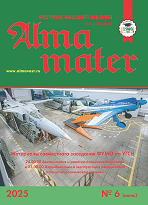UDC 378-028.42:53
https://doi.org/10.20339/AM.04-21.020
M.A. Arkulis is Cand. Sci. (Pedagogy), Ass. Prof., Head of Department of Physics e-mail: arkulis78@mail.ru; A.A. Nikolaev is student of Department of Computer Science and Programming e-mail: aanton2001@gmail.com; O.S. Logunova is Dr. Sci. (Technics), Prof., Head of Department of Computing Technology and Programming e-mail: logunova66@mail.ru; Yu.I. Savchenko is Cand. Sci. (Physic & Mathematic), Ass. Prof., Ass. Prof. of Department of Physics e-mail: sav@magtu.ru. All at Nosov Magnitogorsk State Technical University. V.V. Koroleva is Cand. Sci. (Pedagogy), Ass. Prof., Ass. Prof. of Department of Physics and Mathematics at Kazan State Agrarian University e-mail: taisa_67@mail.ru
Presented is the study of developing a theory of practice of synergetic design and virtual physical laboratories to increase the level of compliance with reality and reduce the level of learner’s immersion in the virtual environment. The authors considered one of the objectives leading to the achievement of the goal, the use of synergistic aspect in the digitalization of physical education which allows consolidating virtuality and reality of the surrounding world, and use the “positive” effects to form new physical knowledge of the learner. The authors defined the requirements for digital physics labs, which should provide realism, interactivity, automation and virtualization. The distinctive feature of the research is the synergetic aspect, which consolidates subject knowledge, mathematical modeling and philosophical reflection. The combination of these components made it possible to synthesize a new form of digital physical laboratory and to perform its software implementation based on the developed scenario diagram for the incoming actors. The software implementation of the digital physical laboratory required: preparation of video clips with a series of physical experiments, definition of the laboratory work order (progress) and examples of “return” from virtual reality. The testing of the synergetic aspect and the possibility of its realization was done on the example of a digital laboratory work in the study of the fall of a body.
Key words: physical education; high school; digitalization of education; synergistic aspect; scenario diagram.
References
1. Ilyasov, V.Kh., Shambulina, V.N. Directions of development of methods of lecturing and practice oriented approach to lecturing in course of physics. Baltic Humanitarian Journal. 2018. Vol. 7. No. 2 (23). P. 247–250.
2. Buraya, L.V., Kovazhenkov, M.A., Koroleva, V.V. and al. The system of professional education in Russia. Problems and prospects of development. Novosibirsk: Sibprint, 2011. Vol. 2. 184 p.
3. Lisenkova, A.A. Challenges and possibilities of digital epoch: socio-cultural aspect. Russian humanitarian journal. 2018. Vol. 7. No. 3. P. 217–221.
4. Gundyrev, V.B., Koroleva, E.N., Losev, V.V. et al. Virtual experiment and computer modeling in project creative activity of students in the system of continued engineering education. In: Professional creative activity of a pedagogue. Cheboksary: Izd-vo Chuvashskii gosudarstvennyi pedagogicheskii universitet im. I.Ya. Yakovleva, 2018. P. 89–96.
5. Pechinnikova, I.K. Using of information technologies during lecturing of physics. Vestnik RUDN. Series: Informatization of education. 2007. No. 4. P. 22–29.
6. Kochergina, N.V., Mashinyan, A.A. Training of a teacher for using computer and audio-visual means in the process of lecturing physics. Uchenye zapiski Zabaikalskogo gosudarstvennogo gumanitarno-pedagogicheskogo universiteta im. N.G. Chernyshevskogo. 2009. No. 2 (25). P. 74–80.
7. Ivanov, A.F., Egorelov, S.E., Logunova, E.V. Using of innovation technologies during lecturing of physics. Elektronnyy nauchno-metodicheskii zhurnal Omskogo GAU. 2015. No. 1. URL: http://ejournal.omgau.ru/index.php/2015-god/1/16-statya/63-00015
8. Nemykina, T.I., Pavlova, M.A., Yaroslavtsev, A.S. Information technologies in educational process in lecturing mathematics and physics. Sovremennye naukoemkie tekhnologii. 2008. No. 10.
9. Chernykh, I.S. Using of labor safe approaches to lecturing of physics. Vestnik of experimental education. 2016. No. 3 (6). P. 1–10.
10. Molotkov, S.G. Electronic means in lecturing in physics. Information communicative technologies in pedagogical education. 2016. No. 3 (41). P. 187–192.
11. Selyutin, A.A. Formation of guarded attitude to Russian language in social media: regularity or paradox? Vestnik Chelyabinskogo gosudarstvennogo universiteta. 2017. No. 11 (407). P. 54–57.
12. Bourina, H.V., Dunaeva, L.A. Formation of student’s hypertext competence using hypertext technologies. E-Learning and Digital Media. 2021. Vol. 18. No. 1. P. 39–54.
13. Samutina, N. Elusive Readers: Russian-Language Popular Culture Transformations as a Challenge for Researchers of Literary Practices. Russian Literature. 2020. No. 118. P. 1–24.
14. Meshcheryakova, E.V., Mironova, G.V., Mursenkova, I.V. Methodological using of illustrative material in lecturing of physics. Vestnik Tsentra mezhdunarodnogo obrazovaniia Moskovskogo gosudarstvennogo universiteta. Filologiia. Kulturologiia. Pedagogika. Metodika. 2010. No. 4. P. 121–134.
15. Chernavsky, D.S. Synergy and informatics: dynamic theory of informatization. Moscow: Knizhnyi dom “Librokom”, 2016. 304 p.
16. Logunova, O.S., Lednov, A.V., Arefeva, D.Ya. et al. Synergetics. Magnitogorsk: Izd-vo Magnitogorsk. gos. tekhn. un-ta im. G.I. Nosova, 2020.
17. Logunova, O.S., Ilina, E.A. Structural lexical graphic information in elaboration by program supplying. Mathematical and program supply of systems in industrial and social spheres. 2014. No. 1 (4). P. 87–91.











.png)






